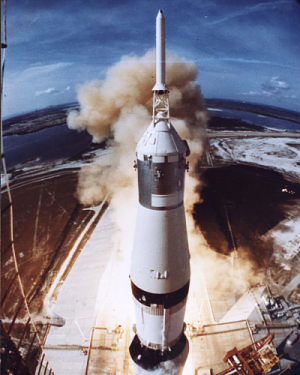Published: July 16, 2019
On May 25, 1961, President John F. Kennedy addressed Congress and the Nation saying, "I believe that this Nation should commit itself to achieving the goal, before the decade is out, of landing a man on the Moon and returning him safely to Earth." See the President's full address, a Special Message to Congress on Urgent National Needs, including support for the Nation's space program, as printed in the Congressional Record (107 Cong. Rec. (Bound) - House of Representatives).
Eight years later, President Kennedy's vision for the Nation became reality. Apollo 11, the spaceflight that landed the first two people on the Moon, launched from Cape Kennedy on Merritt Island, Florida, 50 years ago, on July 16, 1969. It carried Commander Neil Armstrong, Command Module Pilot Michael Collins and Lunar Module Pilot Edwin "Buzz" Aldrin.
On the day of the launch, President Richard M. Nixon honored the mission and proclaimed:

"Apollo 11 is on its way to the Moon. It carries three brave astronauts; it also carries the hopes and prayers of hundreds of millions of people here on Earth, for whom that first footfall on the Moon will be a moment of transcendent drama. Never before has man embarked on so epic an adventure."
At 4:18 p.m. on July 20, Neil Armstrong's voice could be heard through the speakers at NASA's Mission Control in Houston. He said, "The Eagle has landed." This referred to the Lunar Module named the Eagle landing on the moon. An estimated half a billion people watched a live broadcast of the landing and listened intently as Armstrong famously describe taking "...one small step for a man, one giant leap for mankind."
President Nixon's 1969 Public Papers contain the July 20 Telephone Conversation with the Apollo 11 astronauts on the Moon (p. 530), and July 24 Remarks to Apollo 11 Astronauts aboard the U.S.S. Hornet following completion of their Lunar Mission (p.541).
President Nixon also designated July 20, 1971, as National Moon Walk Day to commemorate the anniversary of the first moon walk (85 Stat. 919, Proclamation 4067).
Apollo 11 Mission Highlights:
- First men on the Moon, Neil Armstrong, and Buzz Aldrin
- Photographs from the Moon's surface, including the lunar horizon, surrounding area, and landing site
- First samples from another planetary body
- Deployment of several tools and scientific experiments, including a Laser-Ranging Retroreflector (LRRR), a Passive Seismic Experiment Package (PSEP), and a Solar Wind Composition (SWC) experiment
- Plaque affixed to the leg of the lunar landing vehicle signed by President Nixon, Neil A. Armstrong, Michael Collins and Edwin E. Aldrin, Jr. The plaque bears a map of the Earth and this inscription:
HERE MEN FROM THE PLANET EARTH
FIRST SET FOOT UPON THE MOON
JULY, 1969 AD.
WE CAME IN PEACE FOR ALL MANKIND
While Armstrong and Aldrin landed on the Moon, the third astronaut, Michael Collins, had an arguably even more important job. He was responsible for piloting the command module, continuous monitoring, being ready to rescue the astronauts if need be, and picking up the other two astronauts to go back home at the end of the mission. Though he didn't land on the Moon and is often known as the "Forgotten Astronaut," Collins was needed to operate the Command/Service Module. (Source: Nasa.gov )
Because no one knew what kinds of things may be living on the Moon, when they returned to Earth, Armstrong, Aldrin and Collins were taken into quarantine to prevent any possible contamination of micro-organisms from the Moon. Check out the July 15, 1969, contamination proceedings as printed in the Congressional Record (115 Cong. Rec. (Bound) - Senate).
The three astronauts received the Congressional Gold Medal on August 7, 2008, with the enactment of the New Frontier Congressional Gold Medal Act (123 Stat. 1966).
Related Resources
- Congressional hearings related to NASA including "America in Space: Future Visions, Current Issues" (March 13, 2019) and "Sixty Years of NASA Leadership in Human Space Exploration: Past, Present, and Future" (September 26, 2018), both hearings before the House Committee on Science, Space, and Technology.
- Search Federal Register rulemaking documents and notices issued by NASA.
- Browse or Search legislation related to National and Commercial Space Programs codified in Title 51 of the U.S. Code.
- Browse or Search regulations related to Aeronautics and Space in Title 14 of the Code of Federal Regulations.
- View documents published by the House Science, Space, and Technology Committee and the Senate Commerce, Science and Transportation Committee.
- Find NIST publications related to NASA including proceedings of a conference on space simulation.
- Visit the U.S. Government Publishing Office Bookstore's website to purchase NASA publications.
Source for this article except where specifically noted is Apollo 11 Mission Overview on Nasa.gov.